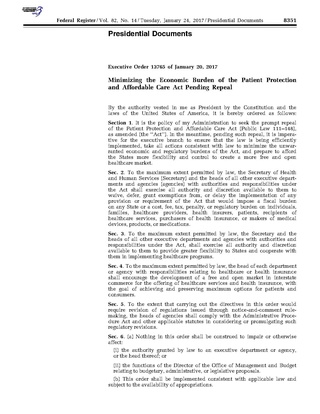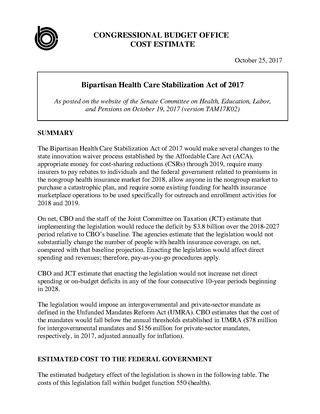
Patrick Joseph Tiberi is an American lobbyist and politician who served as the U.S. representative for Ohio's 12th congressional district from 2001 to 2018. His district included communities north and east of Columbus. He is a member of the Republican Party, and previously served in the Ohio House of Representatives from 1993 to 2000. He briefly served as Chair of the new Republican Main Street Congressional Caucus from September 7, 2017.
Families USA is a nonprofit, nonpartisan consumer health advocacy and policy organization.

In the United States, health insurance coverage is provided by several public and private sources. During 2019, the U.S. population overall was approximately 330 million, with 59 million people 65 years of age and over covered by the federal Medicare program. The 273 million non-institutionalized persons under age 65 either obtained their coverage from employer-based or non-employer based sources, or were uninsured. During the year 2019, 89% of the non-institutionalized population had health insurance coverage. Separately, approximately 12 million military personnel received coverage through the Veteran's Administration and Military Health System.
In the United States, health insurance marketplaces, also called health exchanges, are organizations in each state through which people can purchase health insurance. People can purchase health insurance that complies with the Patient Protection and Affordable Care Act at ACA health exchanges, where they can choose from a range of government-regulated and standardized health care plans offered by the insurers participating in the exchange.
A health insurance mandate is either an employer or individual mandate to obtain private health insurance instead of a national health insurance plan.

The Affordable Care Act (ACA), formally known as the Patient Protection and Affordable Care Act (PPACA) and colloquially known as Obamacare, is a landmark U.S. federal statute enacted by the 111th United States Congress and signed into law by President Barack Obama on March 23, 2010. Together with the Health Care and Education Reconciliation Act of 2010 amendment, it represents the U.S. healthcare system's most significant regulatory overhaul and expansion of coverage since the enactment of Medicare and Medicaid in 1965.
The Affordable Care Act (ACA) is divided into 10 titles and contains provisions that became effective immediately, 90 days after enactment, and six months after enactment, as well as provisions phased in through to 2020. Below are some of the key provisions of the ACA. For simplicity, the amendments in the Health Care and Education Reconciliation Act of 2010 are integrated into this timeline.
King v. Burwell, 576 U.S. 473 (2015), was a 6–3 decision by the Supreme Court of the United States interpreting provisions of the Patient Protection and Affordable Care Act (ACA). The Court's decision upheld, as consistent with the statute, the outlay of premium tax credits to qualifying persons in all states, both those with exchanges established directly by a state, and those otherwise established by the Department of Health and Human Services.
United States House of Representatives v. Azar, et al. was a lawsuit in which the United States House of Representatives sued departments and officials within the executive branch, asserting that President Barack Obama acted illegally in his implementation of the Patient Protection and Affordable Care Act. The lawsuit was touted by House Speaker John Boehner, and asserted that President Obama exceeded his constitutional authority in delaying the implementation of the employer mandate of the Affordable Care Act and also addressed "Republican opposition to an estimated $175 billion in payments to insurance companies over the next 10 years as part of a cost-sharing program under the healthcare law."

Rodney Leland Blum is an American businessman and politician who served as the U.S. representative for Iowa's 1st congressional district from 2015 to 2019. A member of the Republican Party, he was first elected in 2014 and won a second term in the 2016 elections.
The following is a list of efforts to repeal the Affordable Care Act, which had been enacted by the 111th United States Congress on March 23, 2010.

The following is a list of plans which were considered to replace the Affordable Care Act during the Donald Trump administration. The plans were considered after the Republican Party gained a federal government trifecta in 2016. "Repeal and replace" has been a Republican slogan since March 2010 when the ACA was signed into law and had been adopted by former President Donald Trump.

Executive Order 13765 is the first executive order signed by former U.S. President Donald Trump on January 20, 2017, which set out interim procedures in anticipation of repeal of the Affordable Care Act (Obamacare).

The American Health Care Act of 2017 was a bill in the 115th United States Congress. The bill, which was passed by the United States House of Representatives but not by the United States Senate, would have partially repealed the Affordable Care Act (ACA).
The "Jimmy Kimmel test" is a political litmus test used in political discourse in the United States during 2017 efforts to repeal the Affordable Care Act. First proposed by United States Senator Bill Cassidy, the test was used throughout 2017 to frame political debate over health care reform, and Cassidy's use of it in September 2017 prompted comedian and late-night talk show host Jimmy Kimmel to publicly attack a Senate health care bill co-sponsored by Cassidy. The resulting public debate contributed to the failure of the Senate bill.

Graham–Cassidy or Graham–Cassidy–Heller–Johnson is the common name for Senate Amendment 1030 to the American Health Care Act of 2017. S.Amdt. 1030 was introduced on September 13, 2017, sponsored by Lindsey Graham (R-SC), with Bill Cassidy (R-LA) as a co-sponsor, after whom the amendment is named. The other three co-sponsors are Dean Heller (R-NV), Ron Johnson (R-WI), and Roy Blunt (R-MO). The amendment would repeal the Affordable Care Act (ACA), also known as Obamacare. It would also return control of the Medicaid program to the states and cap the program's funding. The amendment would also redistribute federal money differently to different states, with some states that expanded Medicaid under the ACA losing federal money to states that did not.

The Bipartisan Health Care Stabilization Act of 2017 was a 2017 proposed compromise reached by senator and HELP Committee chairman Lamar Alexander and senator and HELP Committee ranking member Patty Murray to amend the Affordable Care Act to fund cost-sharing reductions subsidies. The plan will also provide more flexibility for state waivers, allow a new "Copper Plan" or catastrophic coverage for those under 30, allow interstate insurance compacts, and redirect consumer fees to states for outreach. President Trump had stopped paying the cost sharing subsidies and the Congressional Budget Office estimated his action would cost $200 billion, cause insurance sold on the exchange to cost 20% more and cause one million people to lose insurance.
The cost sharing reductions (CSR) subsidy is the smaller of two subsidies paid under the Patient Protection and Affordable Care Act (ACA) as part of the healthcare system in the United States. The subsidies were paid from 2013 to 2017 to insurance companies on behalf of eligible enrollees in the ACA to reduce co-payments and deductibles. They were discontinued by President Donald Trump in October 2017. The nature of the subsidy as discretionary spending versus mandatory was challenged in court by the Republican-controlled House of Representatives in 2014, although payments continued when the ruling in favor of the GOP was appealed by the Obama administration. The non-partisan Congressional Budget Office (CBO) estimated that ending the payments would increase insurance premiums on the ACA exchanges by around 20 percentage points, resulting in increases in the premium tax credit subsidies, thereby adding nearly $200 billion to the budget deficits over the following decade. Critics argued the decision was part of a wider strategy to "sabotage" the ACA.
The Patient Protection and Affordable Care Act, often shortened to the Affordable Care Act (ACA) or nicknamed Obamacare, is a United States federal statute enacted by the 111th United States Congress and signed into law by President Barack Obama on March 23, 2010. Together with the Health Care and Education Reconciliation Act of 2010 amendment, it represents the U.S. healthcare system's most significant regulatory overhaul and expansion of coverage since the passage of Medicare and Medicaid in 1965. Once the law was signed, provisions began taking effect, in a process that continued for years. Some provisions never took effect, while others were deferred for various periods.
California v. Texas, 593 U.S. ___ (2021), was a United States Supreme Court case that dealt with the constitutionality of the 2010 Affordable Care Act (ACA), colloquially known as Obamacare. It was the third such challenge to the ACA seen by the Supreme Court since its enactment. The case in California followed after the enactment of the Tax Cuts and Jobs Act of 2017 and the change to the tax penalty amount for Americans without required insurance that reduced the "individual mandate" to zero, effective for months after December 31, 2018. The District Court of the Northern District of Texas concluded that this individual mandate was a critical provision of the ACA and that, with a penalty amount equal to zero, some or all of the ACA was potentially unconstitutional as an improper use of Congress's taxation powers.









